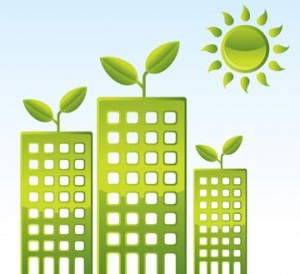According to a recent article in the Daily Journal of Commerce, Oregon has been knocked from its top ranking position as leader in green design projects. Surely this loss comes as a mighty blow to the state known for its environmental friendliness. Apparently granola eating and tree hugging are no longer viable qualifications to “count” as a leader in green advancements. Now, filling out the right forms, checking the right boxes, and providing the right funds guarantees you a top spot on the environmental rankings. It’s no surprise with this type of bureaucracy then that Washington, D.C. has shimmied its way to the number one spot. With all this red tape for green causes, it seems like you have to pass through a sea of Christmas decorations to see your state’s name on that leader board.
In actuality, Oregon is quite an environmentally friendly state, and as the article points out, LEED projects are not the only way a state is making green decisions. However,  the fear of being perceived as dropping from the top spot has important implications. In the green revolution, did we lose sight of the real goal at hand, or has the battle to have the shiny gold star made states and other entities alike sacrifice the value of green innovation in order to surrender to the specific qualifications that will put them on top?
the fear of being perceived as dropping from the top spot has important implications. In the green revolution, did we lose sight of the real goal at hand, or has the battle to have the shiny gold star made states and other entities alike sacrifice the value of green innovation in order to surrender to the specific qualifications that will put them on top?
Competition has always been a source of ingenuity, creativity, and entrepreneurship in the U.S., and when we are able to translate this American ideology to important issues such as environmental sustainability, a lot can be accomplished. In the last decade, new measures for recognizing green design have been introduced. In 2000 the U.S. Green Buildings Council created the Leadership in Energy and Environmental Design certification program (LEED). LEED provides an innovative way to recognize building owners and operators for their excellence in green design. LEED provides a checklist of design elements that strive to achieve sustainable site development, water savings, energy efficiency, materials selection and indoor environmental quality. The checklist offers flexibility in which design elements builders want to gain points in, allowing them to sacrifice environmentally sustainable elements in others. A LEED certification can be granted to a variety of buildings including new building projects, commercial interiors, schools, homes, and more, and these projects can be awarded a certified, silver, gold, or platinum label in accordance to the number of points the “scored” on their checklist.
The ranking system referred to at the beginning of the article is based off of the  number of LEED certified building projects in each state or district. With the ranking system, a new competitive framework surrounds the way state governments and private companies think about green design. With constituents and consumers beginning to demand environmentally sustainable spaces, pressure builds to gain the most and the highest LEED certifications. Problems can arise from this competition, however, when the builders and consumers are so focused on the score they fail to do what is best for the space.
number of LEED certified building projects in each state or district. With the ranking system, a new competitive framework surrounds the way state governments and private companies think about green design. With constituents and consumers beginning to demand environmentally sustainable spaces, pressure builds to gain the most and the highest LEED certifications. Problems can arise from this competition, however, when the builders and consumers are so focused on the score they fail to do what is best for the space.
As an anecdote; when I was given a tour of the new LEED approved dormitory on the George Washington campus I was shown all the spiffy bamboo wallpaper and recycled cork floors, but when I began to look around, a lot of efficient, common-sense design elements were not in place. For example, three bright new shining elevators greeted you at the entranceway, but there were no stairs in sight. In order to take the stairs, you would have to walk around the entire floor. While I’m certainly not an electricity expert, it would appear to me to be more economically and environmentally efficient to have easy access to climb two, three, or four sets of stairs rather than take an elevator? But, alas, average elevator rides are not a LEED checklist item, so common sense (at least common sense to me) did not come into the design.
From states to universities to hotels to homes, everyone seems to want the advantage as a recognized, certified, or classified environmentally friendly space. Although I welcome this form of competition, I would also advise both consumers and builders to look past the initial labeling. Explore what the space is really doing to mitigate environmental degradation and ask if it could be doing more. Challenge yourself to step outside the checkbox on the paperwork and decide to be your own judge for green building and progress.
Tracey Shipman is a senior at the George Washington University studying public policy, economics, and peace studies. As a Program and Research Intern for the SISGI Group, she researches environmental sustainability, education, and economic development.


2 pings